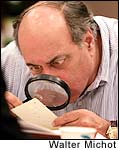
Brooklyn Dodger Comments:
The Dodger grew up as a chemicals person. Chemicals are by no means "over." But the dangerous exposure of this year is mold inside Katrina-flooded houses in NOLA. What's the public health approach, and is there a way toward a quantitative exposure-based set of control measures?
"Biological" agents include infectious materials [TB, anthrax, SARS, flu], mold [spores], animal wastes [swine confinement, pigeons, bird droppings (which are infectious)], flour dust, pollen, and components of metalworking fluids. Biological agents share character with carcinogens, specifically, carcinogens in which aerosol exposure is the primary route.
Biological agents share with carcinogens the presumption of no practical threshold to the exposure-response relationship in an exposed [human] population. Absence of a practical threshold in a population may arise from a non-zero probability that a single organism or spore may give rise to infection. It may arise from an allergic [immune mediated] type of response, in which some population of pre-exposed and sensitized people will respond to vanishingly small doses. Or, there may be specially sensitive sub-populations without known pre-exposure.
Carcinogens threaten an irreversible increased risk of developing a progressive and potentially fatal condition after removal from exposure. That is, a future risk from past exposure. Effects of biological agents may also progress on removal; for example, an exposure triggered asthma condition may develop cross reaction to common community exposures and progressively damage the respiratory system.
For an individual, a "threshold" - the lowest exposure which will produce the effect - may be presumed, but it's of no practical use. The individual who suffers the effect was exposed above the individual's threshold [level, duration, schedule and latency], the individual who escapes was exposed below [or a censored by suffering an intervening alternative condition], but this can only be known after. The distribution of individual thresholds sums to the population exposure response relationship. The Dodger imagines there is a central tendency and dispersion of the probability of effect at each dose. BrooklynDodger imagines definable sub-populations [for example, some genetic marker for sensitivity, or some co-exposure] and variation in resistence in a single population.
Now, back to mold in buildings. The problem is there are unknowable numbers of species, sub species, varieties or whatever of mold. Unknowable means unmeasureable. Unmeasurable means no means of determining exposure-response. Molds fling spores into the air. There's mold stuff in the air all the time, everywhere, and there are people who suffer frequently, all the time [hay fever] and who take medicine all the time. They suffer more when their own private exposure is higher, and less when it's lower. Frequently a troubled building will have less measureable mold material in the air than outside, but its different mold.
There's some evidence that molds also produce vapor phase contaminants [3-methyl furan, or 3-MF] which have biological effect.
This handwaving suggests an explanation for people continuing to complain of symptoms after mold has been removed from a building - they are the sensitive or sensitized sub-population or people at the bottom of the exposure response curve. Assume for the sake of argument the building has an acceptable volume of acceptably cleaned air. Contrary to all the Dodger's ideals, these people need medicine, or respiratory protection, or else have to tough it out or leave.
The Dodger will futurely post on occupational health protections for mold remediation and other biological exposures.

No comments:
Post a Comment